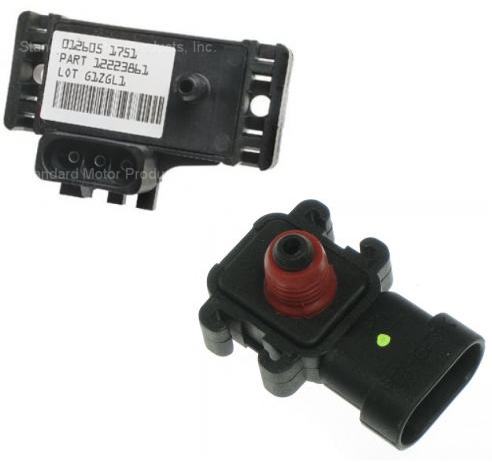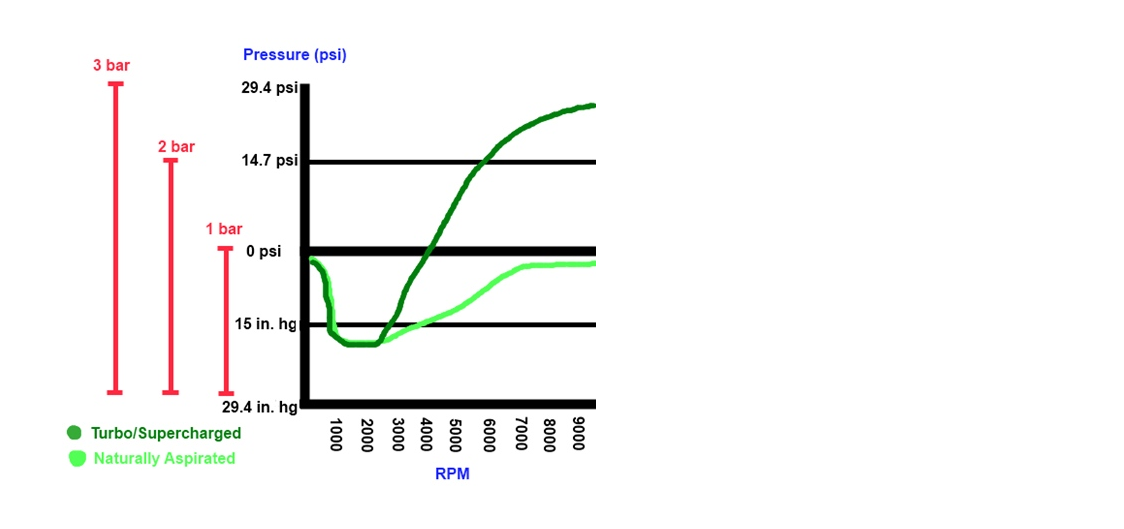What is a MAP Sensor & What does a MAP Sensor do?
What Manifold Absolute (MAP) Sensors Are, What They Do, and Basic Terms
- MAP is an acronym for Manifold Absolute Pressure. MAP sensors measure the air pressure in your intake manifold, which helps the engine's computer determine air / fuel ratios. MAP sensors are set to "zero" from the factory. With the car off and the key on, the MAP sensor will read "zero" at sea level.
- There is 14.7 Pounds per Square Inch (psi) on us at all times at sea level.
- "Bar" is a measurement of pressure. 1 Bar = 1.01352932 atmospheric pressure, which is 14.7 psi. (We'll say 1 Bar for simplification)
- The absence of pressure is measured in "Inches Of Mercury" (abbreviated as in. Hg).
- -1 Bar = -29.4 in. Hg
- 1 Bar = 29.4 in. Hg
- Naturally Aspirated = without a turbocharger or supercharger. Also known as "N/A".
- Forced Induction = with a turbo or supercharger
- In forced induction applications "Boost" is automotive slang for psi
- Stoichiometric Air Fuel Ratio = The ratio of the exact amount of air it takes to burn a fuel completely.
- Stoichiometric for Gasoline Engines = 14.7 : 1 (14.7 parts air to 1 part fuel).

How MAP Sensors Work
With an N/A engine running, the MAP sensor may see readings anywhere from -29.4 in. Hg to 0 psi depending on how hard you smash the pedal. The more you hit the throttle, the closer to 0 psi the MAP sensor will read, because there is less vacuum in the intake manifold. On an engine with forced induction, the MAP sensor will also measure boost.
When MAP sensor data is combined with an air temperature sensor and a known engine speed, the engine's computer (ECU) can accurately calculate the air flow rate of the engine, which then means it can calculate fuel. It does this with fuel maps that are programmed into the ECU. The fuel map guides the engine to its happy stoichiometric place.

Why Do Some Owners Use 3 or 3.3 Bar MAP Sensors on Cars They Don't Belong On?
Some cars that come stock with superchargers or turbochargers have 3 or 3.3 bar MAP sensors from the factory. So horsepower addicts like to take their own project car, stuff more boost into it than it was ever intended to have, and run a tune-able computer system to handle the changes. Since a 1 Bar sensor can only read up to 14.7 psi (which is really zero here on earth), a 1 Bar sensor can't handle any forced induction applications. Any type of forced induction puts pressure (above zero) into the intake manifold, and therefore horsepower seekers need a MAP sensor that can accurately read those pressures. This is where the 3 or 3.3 Bar comes into play.
A 3 Bar sensor can read up to 44.1 psi (Subtract the 14.7 psi of atmosphere, and it can actually can read up to 29.4 psi). If a person were to put a 1 Bar sensor where a 3 Bar goes, the ECU would malfunction when the boost arrives, and wouldn't know what to do with the air/fuel ratio because the numbers on the fuel maps don’t add up. 3 and 3.3 Bar sensors are perfect for this because of their simple 3 wire connector, reliability, and accuracy.
MAP Sensor Pressure Range Graph

